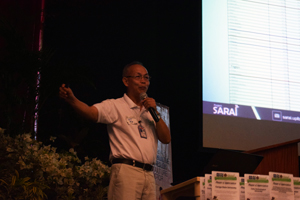
Dr. Artemio M. Salazar, Professor at the Institute of Plant Breeding, University of the Philippines Los Baños, (IPB-UPLB), presented the outputs of the project titled, “Environmental Characterization and Development of Integrated Crop Management,” which is Project 2 of the program, Smarter Approaches for Reinvigorated Agriculture as an Industry (SARAI) in the Philippines.
SARAI, a program funded by the Philippine Council for Agriculture, Aquatic and Natural Resources Research and Development of the Department of Science and Technology (DOST-PCAARRD), is designed to be a nationwide online platform for smarter decisions on agricultural farming activities. It is implemented by the University of the Philippines Los Baños (UPLB) in collaboration with selected state colleges and universities (SUCs), local government units (LGUs), and private partners.
The other component projects include: Project 1. Model development and crop forecasting; Project 3. SARAI knowledge portal; Project 4. Capacity and knowledge building; and Project 5. SARAI mainstreaming.
As Project 2 leader, Salazar explained how SARAI optimizes the use of advances in technology as tools for environmental characterization to achieve smarter agriculture.
Among these technologies are the use of remote sensing and geographic information systems, Automatic Weather Station (AWS), and Unmanned Aerial Vehicle (UAV).
The said technologies and tools are essential towards developing decision support models for crop forecasting, crop advisories, and early warning systems. They provide visual information on suitability, vulnerability, hazard, and crop production areas to help farmers attain maximum production and profit.
Normalized Difference Vegetation Index (NDVI), on the other hand, relates remote sensing measurements and determines whether the target being observed contains live green vegetation or not.
NDVI is used worldwide to estimate crop yields, pasture performance, and rangeland carrying capacities among others. It is often directly related to other ground parameters such as percent of ground cover, photosynthetic activity of the plant, surface water, leaf area index and the amount of biomass.
Salazar was exuberant that with all these technologies, the country’s agricultural sector can plan logistics from planting to harvesting.
